Text Adventures & Interactive Fiction on S60 3rd Edition
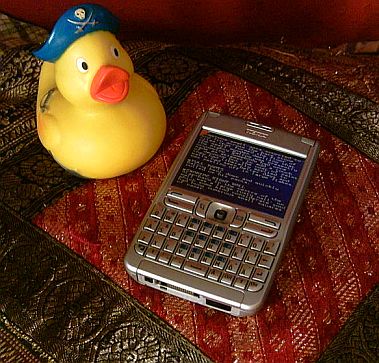 Gaming in recent years has been dominated by the console. Games themselves have become defined by this, using simple direct controls where you're usually moving something from one place to another in a very visual way. It wasn't always this way though...
Gaming in recent years has been dominated by the console. Games themselves have become defined by this, using simple direct controls where you're usually moving something from one place to another in a very visual way. It wasn't always this way though...
Before the era of home computing that exploded in the early 1980s, the graphical capacity of computers was very limited as they mostly dealt with text and numbers. Some systems didn't even have monitors and communicated information entirely through printouts. Early experiments with graphical games were extremely primitive, with only one or two moving objects on-screen at once, so many early games creators turned to text instead. Books are able to conjure up vivid images in people's minds, so these games would rely on prose for atmosphere and vivid gameplay.
The games based on text often had exciting storylines or settings and became known as "Text Adventures" (TAs), but some people prefer the more general term "Interactive Fiction", as there have been some excellent games about more mundane matters too (the famous author Douglas Adams once wrote one called Bureaucracy about someone else being sent your credit card by mistake).
Raiders of the Lost Genre
In the late 1970s and early 1980s, there was something of a split in games: the United States generally went ape over gaming on consoles, first the Atari 2600, then the Nintendo NES, then the Sega Genesis (aka the Mega Drive elsewhere). At the same time Europe generally went ape over gaming on home computers, with the Commodore 64 and Sinclair ZX Spectrum, then the Atari ST and Commodore Amiga, then the PC. This split only ended with the global success of the Sony PlayStation in the mid-1990s, the first ever console to dominate the games market worldwide.The significance of all this is that certain game genres prospered in Europe on home computers throughout the 1980s and early 1990s that were impossible to do on consoles, and these genres then disappeared almost completely as Europe too succumbed to the charms of joypad-only console games systems. One of these "lost" genres is the Text Adventure, it rose and rose until the platform it was designed for began to disappear and was replaced with consoles that couldn't possibly support large amounts of text entry. Added to this was the globalisation of games, where anything linguistic became seen as an added expense due to translation costs, and language became avoided as much as possible, restricted to a few cut scenes at most.
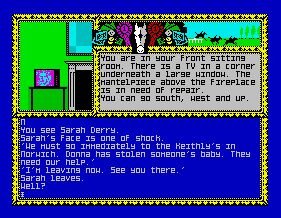 If you're one of the many people who never got the chance to try this unique literary way of gaming, either because of geography or history, now is your chance to relive the genre's 1980s golden age on your Symbian S60 3rd Edition device, thanks to the amazing world of emulation. For practical reasons, it's best if you have a model with a full keyboard such as the E70 or E61, as text adventures by their very nature involve entering a considerable amount of text. This feature has been written using an E61.
If you're one of the many people who never got the chance to try this unique literary way of gaming, either because of geography or history, now is your chance to relive the genre's 1980s golden age on your Symbian S60 3rd Edition device, thanks to the amazing world of emulation. For practical reasons, it's best if you have a model with a full keyboard such as the E70 or E61, as text adventures by their very nature involve entering a considerable amount of text. This feature has been written using an E61.The S60 3rd Edition emulator Speccy simulates the Sinclair ZX Spectrum, an extremely popular British 1980s home computer which had over 1600 text adventures written for it. A recent update to Speccy has fixed a keyboard bug which had made text adventures difficult to play, and an E61 or E70 with Speccy installed on it is now the perfect vehicle for taking interactive fiction with you on the road. Speccy is free to download, so there's no excuse for not having a go!
Getting started with Text Adventures
A player used to graphics-oriented games may find it quite strange to simply type their commands in plain english, but it's no different to reading a book instead of seeing a film. If you can do that, you can get a lot out of TAs.
Because of the limitations of 1980s computers, and computers in general, you can't just type anything in and expect the game to understand you. There's a certain way of talking to the game, usually outlined in the instructions, and the more sophisticated the game the more sophisticated the language it can understand. Once you've played enough of these games it becomes like second nature.
Some commands are common to almost all TAs: compass directions (north, south, etc) and vertical movement (up and down) will move you from one location to another within the game, and areas can be inspected by saying "look". Items and people can be seen in more detail by saying "examine (name of object or person)". You can tell what you're carrying by saying "inventory". Items can usually be used on other objects by saying "use (object) with (other object)". More specific commands are sometimes accepted by the game, and part of the gameplay is often trying to guess what those specific commands might be. The instructions of text adventures are worth looking at, they'll often tell you more about the game's ability to understand what you say.
Let's look at an example to see how it works in practice. The game we're going to play is a very simple one-location adventure called Behind Closed Doors: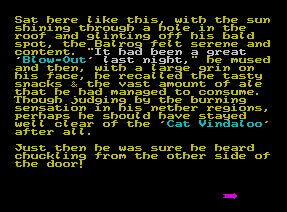 Right, here we go. This is the set-up for the game, it usually lets you know where you are and why. Our hero the Balrog is in the toilet and someone outside is up to no good...
Right, here we go. This is the set-up for the game, it usually lets you know where you are and why. Our hero the Balrog is in the toilet and someone outside is up to no good...
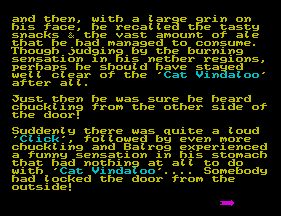 Oh no! Balrog has been locked in! Now the game can begin properly...
Oh no! Balrog has been locked in! Now the game can begin properly...
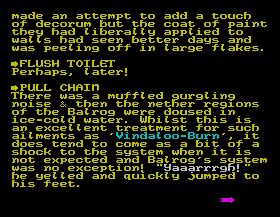 Before we try to get out, let's take care of business first! Aha, now this is an example of getting to know a game's vocabulary: it doesn't understand "flush toilet" but does understand "pull chain", probably because "pull" is a very general verb and "chain" is one of the objects you can see in the room.
Before we try to get out, let's take care of business first! Aha, now this is an example of getting to know a game's vocabulary: it doesn't understand "flush toilet" but does understand "pull chain", probably because "pull" is a very general verb and "chain" is one of the objects you can see in the room.
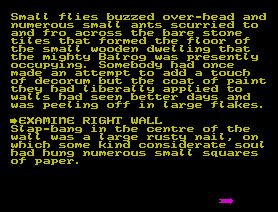 With that taken care of, let's see about leaving this place. This is an unusual game as it's a one-location adventure, so everything can be done by just examining and manipulating our immediate surroundings. First up is examination, which reveals a load of paper pieces nailed to one wall.
With that taken care of, let's see about leaving this place. This is an unusual game as it's a one-location adventure, so everything can be done by just examining and manipulating our immediate surroundings. First up is examination, which reveals a load of paper pieces nailed to one wall.
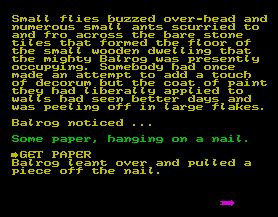 Right, we'd better have some of that paper, it might come in handy. I've seen this done so often on film and TV, you just slide the paper under the locked door, poke the key out, and pull the paper back in with the key on it. Easy!
Right, we'd better have some of that paper, it might come in handy. I've seen this done so often on film and TV, you just slide the paper under the locked door, poke the key out, and pull the paper back in with the key on it. Easy!
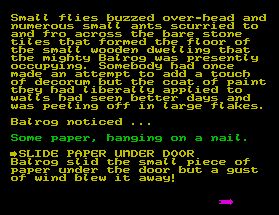 Oh. Didn't quite go according to plan then.
Oh. Didn't quite go according to plan then.
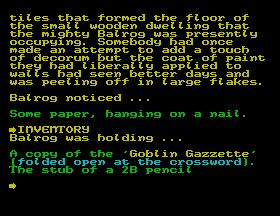 Hmm... time to rethink matters. What are we carrying with us? Ah, a newspaper! Maybe that will be heavy enough to avoid being blown away?
Hmm... time to rethink matters. What are we carrying with us? Ah, a newspaper! Maybe that will be heavy enough to avoid being blown away?
See? It can be quite fun once you get the hang of it... :-)
Most adventures are much more complex than this however, with dozens or hundreds of unique locations instead of one, and many other characters wandering about the place that must be interacted with in order to complete the game. TAs often have time-determined events (as you issue commands, time passes), and you may have to be in the right place at the right time in order to solve a particular task. Many adventures also have illustrations as well as text descriptions.
Unlike most games, text adventures can have complex and involving plots, and if they use text carefully they can evoke feelings and situations that no graphics can. Reading about a world means your imagination fills in all the gaps and creates all the visuals, which are often far more realistic than the latest 3D renderings. As has often been said about radio, the mind creates the best pictures, but it will only do so if there are no existing pictures to take their place.
Speccy for S60 3rd Edition
Speccy emulates all models of the Sinclair ZX Spectrum, but in practice almost all games can be run from the default mode with no settings altered. You simply load the game files to the /others/speccy/ directory of your phone's memory card and the list of available games will appear when you next start the Speccy application. The emulator allows you to save your position in a game and restore it later at any time (press the green Dial/Send key to access options), which suits the stop-and-start nature of portable gaming. It will also automatically restore a game's last saved position when you next load that game in Speccy, or you can reset the emulated hardware from the options menu if you want to start the game from the beginning.
You can set Speccy to stretch the game's screen to fit the phone's, or set it to the original resolution. This feature can be accessed by pressing the green Dial/Send key and switching Zoom Display on or off.
E61 users can use all the letters on their keyboard by pressing the blue Select key in the bottom left corner of the keypad, and if you need to enter numbers press Select again to get back into number mode. A bug on older versions of Speccy prevented this working, but the bug has now been fixed so download the latest version if necessary.
Finding adventure games for Speccy
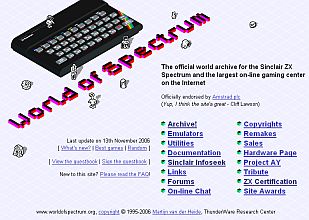 Game files for the ZX Spectrum are mostly technically still in copyright, but many prominent authors and publishers now allow free downloads of their Spectrum games from certain authorised web sites. The best example as far as text adventures are concerned is Zenobi, who were possibly the greatest text adventure publisher on the Spectrum. Their multitude of titles are legally available for free download from the World Of Spectrum text adventure archive, and you can leave feedback on the games to the founder of Zenobi, the Balrog, on their official website's message board .
Game files for the ZX Spectrum are mostly technically still in copyright, but many prominent authors and publishers now allow free downloads of their Spectrum games from certain authorised web sites. The best example as far as text adventures are concerned is Zenobi, who were possibly the greatest text adventure publisher on the Spectrum. Their multitude of titles are legally available for free download from the World Of Spectrum text adventure archive, and you can leave feedback on the games to the founder of Zenobi, the Balrog, on their official website's message board .
(Incidentally it was the Balrog who wrote and starred in Behind Closed Doors, but it was written as a b-side to a proper commercial release rather than being a release in its own right.)
Interview with the Balrog
 So, now you know more about text adventures. But what about the writers behind those adventures? We spoke to the Balrog of Rochdale to find out more:
So, now you know more about text adventures. But what about the writers behind those adventures? We spoke to the Balrog of Rochdale to find out more:
-How is Rochdale at this time of year?
Cold, damp and as depressing as it always is .. must have been mad to have moved here in the first place.
-A lot of kids now are growing up without even knowing what text adventures are. How would the Balrog sell the concept to someone who's never played one before?
Text adventures are the nearest thing I know to an 'interactive' book, but with most of the boring bits removed. They offer the 'player' a chance to pit their wits against those of the game's author(s) whilst enjoying (normally) a good story.
-Will we ever see new games from Zenobi, either for the PC or the Spectrum?
Most probably not. I am now nearly 60 years old and my fingers are far too frail and arthritic to put them through all the typing undertaken in the preparation of a full-blown text adventure. Couple that with the fact that most of the other authors we used to publish are now either retired or dead (only joking .. in case any of them are reading this) and there is not much light on the horizon.
-Apart from Zenobi, which adventure publishing houses did/does the Balrog admire?
Melbourne House, Interceptor Software and CRL to name but a few .. there were dozens of them around and all of them had their good points .. some better than others.
-As well as founding Zenobi software, the Balrog was of course the author of Behind Closed Doors. Was the plot of the game inspired by any real-world events?
Read an article in the local newspaper about an old lady who got locked in her 'outdoor-toilet' by some youths and then wondered how I would handle such an occurence .. hence the 'Behind Closed Doors' saga. I also wanted to write a game using just 'one-location' and that seemed the ideal course to follow.
-Behind Closed Doors is obviously just a short b-side skit, but how long did full commercial Zenobi releases take to create from start to finish?
How mistaken you are .. 'BCD1' was only ever intended as a 'B-side' but such was the response that 'BCD2' became a full-fledged game and 'BCD3' was brought about by hundreds of requests for 'more of the same'. The latter two took months to write and playtest, and there is more coding in them than there is in one or two of my other efforts.
Normally it took about six months to get a game to the 'published' stage .. so it was quite normal to be working on anything up to 10-12 games at one time (all in various stages of completion).
-One of the problems with text adventures from a commercial point of view is that they tend to be closely linked to a particular language. Did Zenobi get many orders from non-English speaking countries?
We had orders from all over the world - Pakistan, China, South America, Hong Kong, South Africa and even Iceland - and from 'english-speaking' countries such as New Zealand and Australia.
-And finally, does the Balrog have much time for these new fangled consoles and their games?
Nothing against them - in fact I have owned a Playstation, a Dreamcast, an Atari Lynx and various Sega systems over the years .. not to mention the good old PC and Amiga machines. They have all had their own merits and have
all produced some excellent games. I am especially fond of Japanese rpgs and have 'wasted' many an hour on the likes of 'Legend of Zelda' and 'Final Fantasy' .. great stories and great action.
